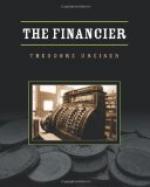place to the enthusiastic comment of such men as Wilton
Ellsworth, Fletcher Norton, Gordon Strake—architects
and art dealers whose judgment and taste were considered
important in Philadelphia. All of the lovely things
by which he had set great store—small bronzes,
representative of the best period of the Italian Renaissance;
bits of Venetian glass which he had collected with
great care—a full curio case; statues by
Powers, Hosmer, and Thorwaldsen—things
which would be smiled at thirty years later, but which
were of high value then; all of his pictures by representative
American painters from Gilbert to Eastman Johnson,
together with a few specimens of the current French
and English schools, went for a song. Art judgment
in Philadelphia at this time was not exceedingly high;
and some of the pictures, for lack of appreciative
understanding, were disposed of at much too low a
figure. Strake, Norton, and Ellsworth were all
present and bought liberally. Senator Simpson,
Mollenhauer, and Strobik came to see what they could
see. The small-fry politicians were there, en
masse. But Simpson, calm judge of good art, secured
practically the best of all that was offered.
To him went the curio case of Venetian glass; one
pair of tall blue-and-white Mohammedan cylindrical
vases; fourteen examples of Chinese jade, including
several artists’ water-dishes and a pierced
window-screen of the faintest tinge of green.
To Mollenhauer went the furniture and decorations of
the entry-hall and reception-room of Henry Cowperwood’s
house, and to Edward Strobik two of Cowperwood’s
bird’s-eye maple bedroom suites for the most
modest of prices. Adam Davis was present and secured
the secretaire of buhl which the elder Cowperwood
prized so highly. To Fletcher Norton went the
four Greek vases—a kylix, a water-jar, and
two amphorae—which he had sold to Cowperwood
and which he valued highly. Various objects of
art, including a Sevres dinner set, a Gobelin tapestry,
Barye bronzes and pictures by Detaille, Fortuny, and
George Inness, went to Walter Leigh, Arthur Rivers,
Joseph Zimmerman, Judge Kitchen, Harper Steger, Terrence
Relihan, Trenor Drake, Mr. and Mrs. Simeon Jones, W.
C. Davison, Frewen Kasson, Fletcher Norton, and Judge
Rafalsky.
Within four days after the sale began the two houses
were bare of their contents. Even the objects
in the house at 931 North Tenth Street had been withdrawn
from storage where they had been placed at the time
it was deemed advisable to close this institution,
and placed on sale with the other objects in the two
homes. It was at this time that the senior Cowperwoods
first learned of something which seemed to indicate
a mystery which had existed in connection with their
son and his wife. No one of all the Cowperwoods
was present during all this gloomy distribution; and
Aileen, reading of the disposition of all the wares,
and knowing their value to Cowperwood, to say nothing
of their charm for her, was greatly depressed; yet
she was not long despondent, for she was convinced
that Cowperwood would some day regain his liberty and
attain a position of even greater significance in
the financial world. She could not have said
why but she was sure of it.




